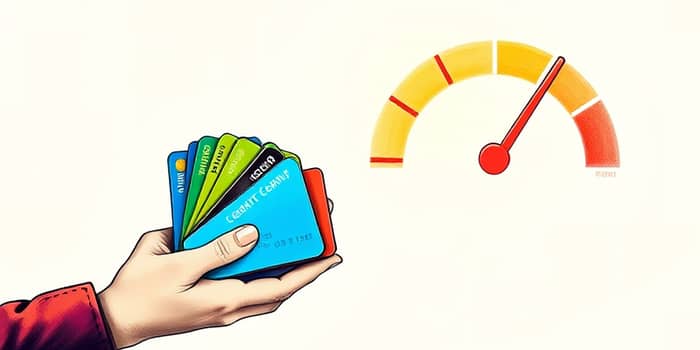Managing credit wisely is a cornerstone of financial health. Among the various metrics lenders examine, credit utilization stands out as one of the most influential factors in determining your creditworthiness.
By understanding how much of your available credit you actually use each month, you can make strategic decisions that improve your borrowing profile and unlock better interest rates and loan approvals.
Definition and Overview
Credit utilization, also known as the utilization ratio, measures the percentage of your available revolving credit that you are currently using. This calculation applies specifically to credit cards and lines of credit.
To determine your utilization ratio, divide your total credit card balances by your total credit limits and multiply by 100. For example, if you have a $300 balance on a card with a $1,000 limit, your utilization is 30%. Keeping track of this percentage provides insight into your borrowing habits and potential risk from a lender’s perspective.
Why Credit Utilization Matters
Lenders and credit scoring models view utilization as a key indicator of responsible credit management. Low utilization suggests you are not excessively reliant on borrowed money, lowering perceived risk.
Credit scoring systems like FICO and VantageScore incorporate utilization heavily. In fact:
- FICO considers utilization at 30% of your overall score.
- VantageScore assigns about 20% weight to utilization.
- Both overall and individual account utilization are evaluated.
Understanding how these percentages influence your score is crucial for anyone looking to maintain or improve creditworthiness.
Impact on Your Credit Score
Credit utilization is the second-biggest factor affecting your credit score, right after payment history, which accounts for 35% of your FICO score. In FICO’s model, utilization alone represents 30% of the total score, making it a critical area to monitor.
Both overall utilization and individual account utilization carry weight. A high balance on a single card can negatively influence your score even if your total utilization across all cards remains moderate. Scoring models examine each account’s balance-to-limit ratio to get a full picture of how you manage credit lines.
Changes in your utilization can have swift effects. If you pay down a large balance before the statement closing date, you may see a score increase within 30 days. However, under newer trended data scoring systems, a recent history of high utilization might continue to impact your score for several months despite lower current balances.
Recommended Utilization Rates
Financial experts generally recommend keeping your utilization ratio under 30% to protect your credit score. For example, with a $3,000 total credit limit, aim to carry less than $900 in balances.
For optimal scores, many professionals advise maintaining utilization in the single digits—below 10%. Research shows individuals with scores above 720 average around 10.2% utilization, while those with scores below 580 often exceed 75.7% utilization.
By targeting a lower ratio, you signal to lenders that you can manage credit responsibly, which may translate into better interest rates and loan approvals.
Effects of High and Low Utilization
High utilization, typically defined as above 30%, can send warning signals to potential lenders. It may imply overspending or financial stress, leading to a drop in your credit score and potentially higher interest rates on new credit.
Conversely, a 0% utilization rate means you’re not using any available credit. While better than high utilization, zero usage offers no evidence of credit handling. Some people prefer to use a small balance each month to demonstrate activity without risking a high ratio.
- Sustained high balances can lower scores quickly.
- Paying down balances immediately can boost your score within one billing cycle.
- In trended data models, a history of high utilization may linger in your scoring profile.
Strategies to Manage and Lower Utilization
Reducing your utilization ratio requires a combination of timely payments, strategic planning, and disciplined spending. The most direct method is to pay down card balances before your statement closes so that credit bureaus report the lower figure.
In addition to timely payments, consider proactive steps such as negotiating higher credit limits or closely scheduling transactions. By adopting these habits, you create a buffer against unexpected expenses and maintain a healthier ratio even during seasonal spending peaks.
- Request higher credit limits and avoid extra spending.
- Make multiple payments before statement close dates to keep reported balances low.
- Spread balances across several cards rather than maxing one out.
Additional Considerations
Remember, credit utilization is only one piece of the puzzle. Payment history, length of credit history, credit mix, and new credit inquiries also play vital roles in your overall score. Monitoring services can help you track utilization trends and receive personalized recommendations.
Quick Facts
Key Takeaways
Maintaining healthy credit utilization is a practical way to safeguard and improve your credit score. By monitoring and managing your balances carefully, you demonstrate reliable borrowing behavior.
- Monitor your balances and limits to calculate utilization accurately.
- Keep utilization under 30%, aiming for below 10% whenever possible.
- Pay down balances before statement dates to rapidly lower reported utilization.
- Utilize credit responsibly to demonstrate consistent financial management.
References
- https://www.experian.com/blogs/ask-experian/credit-education/score-basics/credit-utilization-rate/
- https://www.bankrate.com/credit-cards/advice/credit-utilization-ratio/
- https://www.cbsnews.com/news/how-credit-utilization-affects-your-credit-score-and-what-to-do-about-it/
- https://www.creditkarma.com/credit/i/credit-card-utilization-and-your-credit-score
- https://www.communityfirstfl.org/resources/blog/how-much-does-credit-card-usage-affect-my-credit-score-e853e0b627cf8f1421d2189f16c51e9d
- https://www.capitalone.com/learn-grow/money-management/credit-utilization-and-credit-score/
- https://www.lendingtree.com/credit-repair/credit-utilization-ratio/
- https://www.experian.com/blogs/ask-experian/how-long-will-high-credit-utilization-hurt-credit-score/










